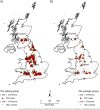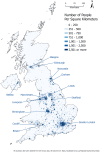Spatial insights into colorectal cancer risk factors and priority areas for screening in the United Kingdom based on data from the UK Biobank
- PMID: 40700416
- PMCID: PMC12286335
- DOI: 10.1371/journal.pone.0328778
Spatial insights into colorectal cancer risk factors and priority areas for screening in the United Kingdom based on data from the UK Biobank
Abstract
Geography and geospatial data science hold the potential to make unique contributions to the reduction of the burden of cancer on society. Here we use colorectal cancer (CRC) as an example to show how spatial insights into CRC risk factors and priority areas for screening may be obtained to achieve geographically targeted screening. We obtained data from the UK Biobank and divided the participants into the older (50<=age < 70) and young (age < 50) adult groups. The data consists of 2,080 CRC cases and 8,062 controls. We used a case-control study and geographically weighted logistic regression (GWLR) to explore spatial variations in risk levels of significant factors at a fine geographic resolution. Analysis results reveal that, among all significant risk factors, polygenic risk score (PRS) is the most important risk factor for both age groups. Findings suggest that the top priority screening areas for older adults, using PRS as the sole risk factor, are between Sheffield, Birmingham, Cardiff, Bristol, and west of Greater London. For young adults, the top priority areas are between the south of Glasgow and Edinburgh and northwest of Greater London. Furthermore, the approach used in this study holds promise for developing more effective targeted cancer screening.
Copyright: © 2025 Yang et al. This is an open access article distributed under the terms of the Creative Commons Attribution License, which permits unrestricted use, distribution, and reproduction in any medium, provided the original author and source are credited.
Conflict of interest statement
The authors have declared that no competing interests exist.
Figures




Similar articles
-
Phenome-wide association study identifies multiple traits associated with a polygenic risk score for colorectal cancer.Hum Genomics. 2025 Jul 9;19(1):77. doi: 10.1186/s40246-025-00791-0. Hum Genomics. 2025. PMID: 40635049 Free PMC article.
-
Chemoprevention of colorectal cancer: systematic review and economic evaluation.Health Technol Assess. 2010 Jun;14(32):1-206. doi: 10.3310/hta14320. Health Technol Assess. 2010. PMID: 20594533
-
Cost-effectiveness of using prognostic information to select women with breast cancer for adjuvant systemic therapy.Health Technol Assess. 2006 Sep;10(34):iii-iv, ix-xi, 1-204. doi: 10.3310/hta10340. Health Technol Assess. 2006. PMID: 16959170
-
Enhancing the use and quality of colorectal cancer screening.Evid Rep Technol Assess (Full Rep). 2010 Feb;(190):1-195, v. Evid Rep Technol Assess (Full Rep). 2010. PMID: 20726624 Free PMC article.
-
Taxane monotherapy regimens for the treatment of recurrent epithelial ovarian cancer.Cochrane Database Syst Rev. 2022 Jul 12;7(7):CD008766. doi: 10.1002/14651858.CD008766.pub3. Cochrane Database Syst Rev. 2022. PMID: 35866378 Free PMC article.
References
-
- The International Agency for Research on Cancer. Cancer today 2024. Available from: https://gco.iarc.fr/today/en. Accessed 2024 July 16.
-
- World Health Organization. Colorectal cancer 2023. Available from: https://www.who.int/news-room/fact-sheets/detail/colorectal-cancer. Accessed 2023 May 24.
MeSH terms
LinkOut - more resources
Full Text Sources
Medical

